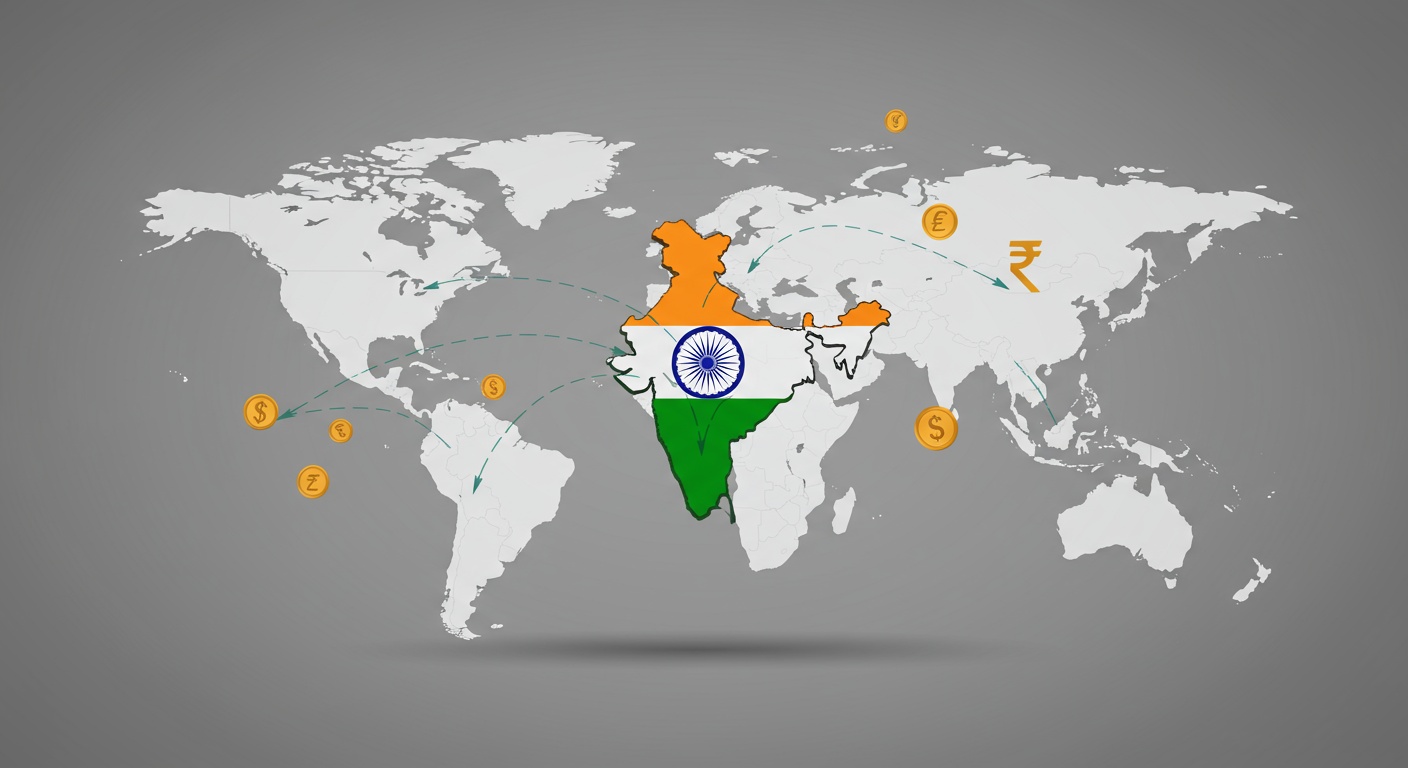India’s outbound foreign investment has surged past the significant $5 billion mark in June, signaling a robust and accelerating push towards global economic expansion. This latest financial milestone underscores the nation’s growing economic confidence and its strategic intent to broaden its international footprint. As global markets navigate complex shifts, this substantial outflow of capital positions India as an increasingly influential player on the world stage, actively participating in and shaping the global economic landscape.

India’s Outbound Foreign Investment Surges Past $5 Billion in June
India’s outbound foreign direct investment (OFDI) witnessed a significant surge in June, crossing the $5 billion mark. This remarkable increase signals a growing confidence among Indian enterprises to expand their global footprint, acquire international assets. Diversify their revenue streams. The latest figures underscore a robust appetite for international expansion, reflecting the maturing capabilities and ambitions of Indian companies on the world stage.
The Reserve Bank of India (RBI) data revealed that Indian companies collectively invested a substantial sum abroad through various channels, including equity, loans. Guarantees. This figure represents a considerable jump compared to previous months, indicating a concentrated effort by domestic entities to capitalize on global opportunities. Such investments are crucial for fostering international trade relations and integrating Indian businesses deeper into global supply chains.
Contextualizing the Growth: A Historical Perspective
While India has been a significant recipient of foreign direct investment, the trend of its domestic companies investing abroad has steadily gathered momentum over the past two decades. Early outbound investments were often driven by resource acquisition or market access in neighbouring countries. But, recent years have seen a diversification in both the sectors and geographical regions targeted by Indian investors. This evolution reflects a strategic shift from opportunistic investments to long-term global integration strategies.
To put June’s performance into perspective, here’s a comparative look at India’s OFDI over the last few months:
| Month | Outbound FDI (USD Billion) | Year-on-Year Growth (%) |
|---|---|---|
| March | 2. 8 | +15% |
| April | 3. 1 | +20% |
| May | 3. 5 | +18% |
| June | 5. 2 | +48% |
The sharp increase in June highlights a particularly aggressive push by Indian corporations, potentially driven by specific large-scale deals or a collective acceleration of pre-planned global expansion strategies.
Drivers Behind the Outbound Investment Surge
Several factors are contributing to this accelerated pace of Indian companies investing abroad. A robust domestic economic environment provides the necessary capital and confidence for firms to look beyond national borders. Moreover, supportive government policies aimed at enhancing India’s presence in global trade and fostering international partnerships play a pivotal role.
- Strategic Mergers & Acquisitions (M&A)
- Diversification and New Markets
- Technology Acquisition
- Enhanced Global Competitiveness
- Government Initiatives
A significant portion of OFDI often comes from Indian companies acquiring foreign entities to gain market share, access new technologies, or expand product portfolios.
Companies are increasingly investing in diverse geographies to reduce dependence on single markets and tap into emerging consumer bases.
Investments in developed markets often aim at acquiring cutting-edge technology and intellectual property, which can then be leveraged back in India.
Establishing a physical presence abroad helps Indian businesses become more competitive, comprehend global consumer preferences. Optimize supply chains.
Policies promoting ‘Make in India for the World’ and strengthening bilateral trade agreements encourage Indian firms to become global players.
“The sustained economic growth within India has empowered our corporates to seek new frontiers for growth and innovation,” stated a senior official from the Ministry of Commerce and Industry. “This outward flow of capital is a natural progression of India’s economic ascent and its growing role in global trade and investment.”
Key Sectors and Regions Attracting Indian Capital
Indian outbound investments are not concentrated in a single sector or region but are increasingly diverse. Historically, sectors like IT and pharmaceuticals led the charge. Now manufacturing, financial services, energy. Even retail are seeing significant capital deployment overseas.
Some of the prominent sectors and regions include:
- data Technology and IT-enabled Services
- Pharmaceuticals and Healthcare
- Manufacturing
- Financial Services
- Energy and Resources
Continued investments in established tech hubs like the US and Europe, as well as emerging markets for digital services.
Acquisitions of manufacturing units, R&D facilities. Distribution networks, particularly in North America and parts of Africa.
Setting up production units in strategic locations to serve regional markets or optimize supply chains, often in Southeast Asia and Europe.
Expanding banking and financial operations to cater to the Indian diaspora and global clients.
Investments in securing raw materials and energy assets, particularly in resource-rich nations.
Geographically, while developed economies continue to be attractive for their technology and market access, there’s a growing interest in emerging markets, especially in Africa and Southeast Asia, driven by their growth potential and bilateral trade agreements.
Broader Implications for India’s Economy and Global Standing
The surge in outbound foreign investment carries profound implications for India’s economy and its position on the global stage. It signifies a maturation of India’s economic capabilities, moving beyond being just a recipient of investment to becoming a significant global investor itself.
The implications include:
- Strengthened Global Presence
- Enhanced Trade Relations
- Technology Transfer and Innovation
- Diversification of Revenue Streams
- Geopolitical Influence
Indian brands and companies gain greater international recognition and market share.
Outbound investments often lead to increased bilateral trade, as Indian companies source inputs or export products to their international subsidiaries. This directly impacts India’s overall trade balance.
Acquired foreign assets often bring new technologies and best practices back to India, boosting domestic innovation and competitiveness.
For Indian corporates, global operations provide diversified revenue streams, making them more resilient to domestic economic fluctuations.
A stronger economic presence abroad can bolster India’s diplomatic and geopolitical influence.
“This trend of increasing outbound investment is a clear indicator of India’s economic coming-of-age,” remarked Dr. Aruna Sharma, a leading economist. “It not only strengthens our international trade linkages but also positions India as a significant player in shaping global economic narratives.”
Stakeholder Perspectives and Official Statements
The robust OFDI figures have been met with optimism by various stakeholders, including government bodies, industry associations. Economic experts. They view this as a positive development that aligns with India’s long-term economic goals.
“The government is fully committed to facilitating Indian businesses in their global aspirations,” stated a spokesperson from the Reserve Bank of India, emphasizing that “while we monitor capital flows closely, a healthy outbound investment trend is indicative of economic strength and diversification.”
Industry bodies also expressed their support for this trend.
“Indian industry is now confident enough to compete and succeed on a global scale,” said the President of the Confederation of Indian Industry (CII). “These investments are not just about capital outflow; they are about building global value chains, securing resources. Enhancing India’s competitive edge in the global trade arena.”
Experts note that the current geopolitical landscape and evolving global trade dynamics might also be prompting Indian companies to diversify their operational bases and supply chains, making strategic overseas investments a priority.
Future Outlook and Potential Challenges
Looking ahead, the momentum for Indian outbound foreign investment is expected to continue, driven by the ambitious growth plans of domestic corporations and a supportive policy environment. But, this expansion is not without its challenges.
- Global Economic Volatility
- Geopolitical Risks
- Currency Fluctuations
- Regulatory Complexities
Economic slowdowns or recessions in target markets could impact the returns on these investments.
Trade tensions, political instability, or regulatory changes in host countries could pose significant hurdles.
Managing foreign exchange risks associated with overseas assets and earnings remains a key concern for companies.
Navigating diverse legal and regulatory frameworks in different countries requires significant expertise and resources.
Despite these potential headwinds, the overarching sentiment is one of cautious optimism. The growing maturity of Indian corporations, coupled with strategic foresight, is expected to enable them to overcome these challenges and continue their trajectory of global expansion, further cementing India’s role in the international investment and trade landscape.










